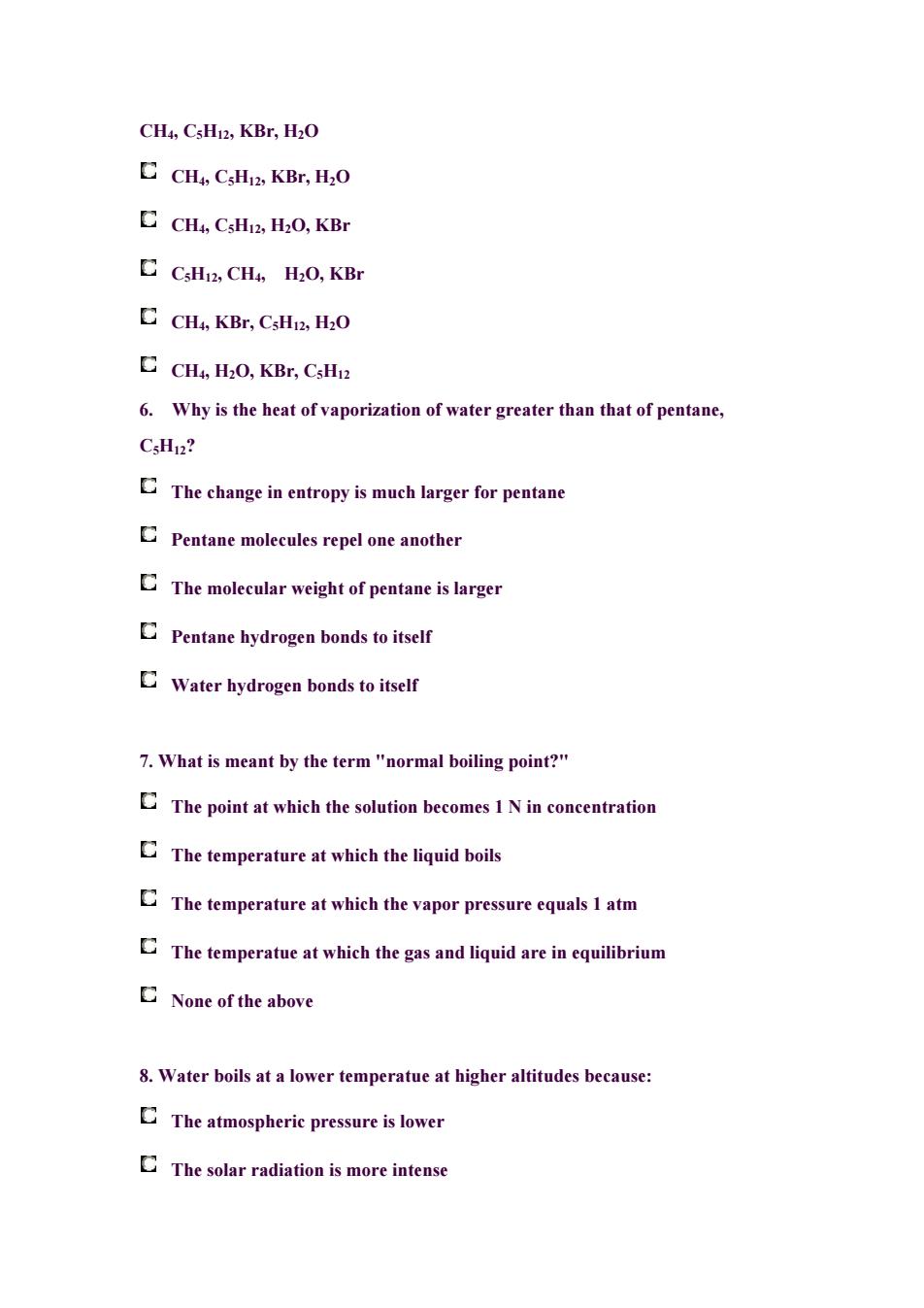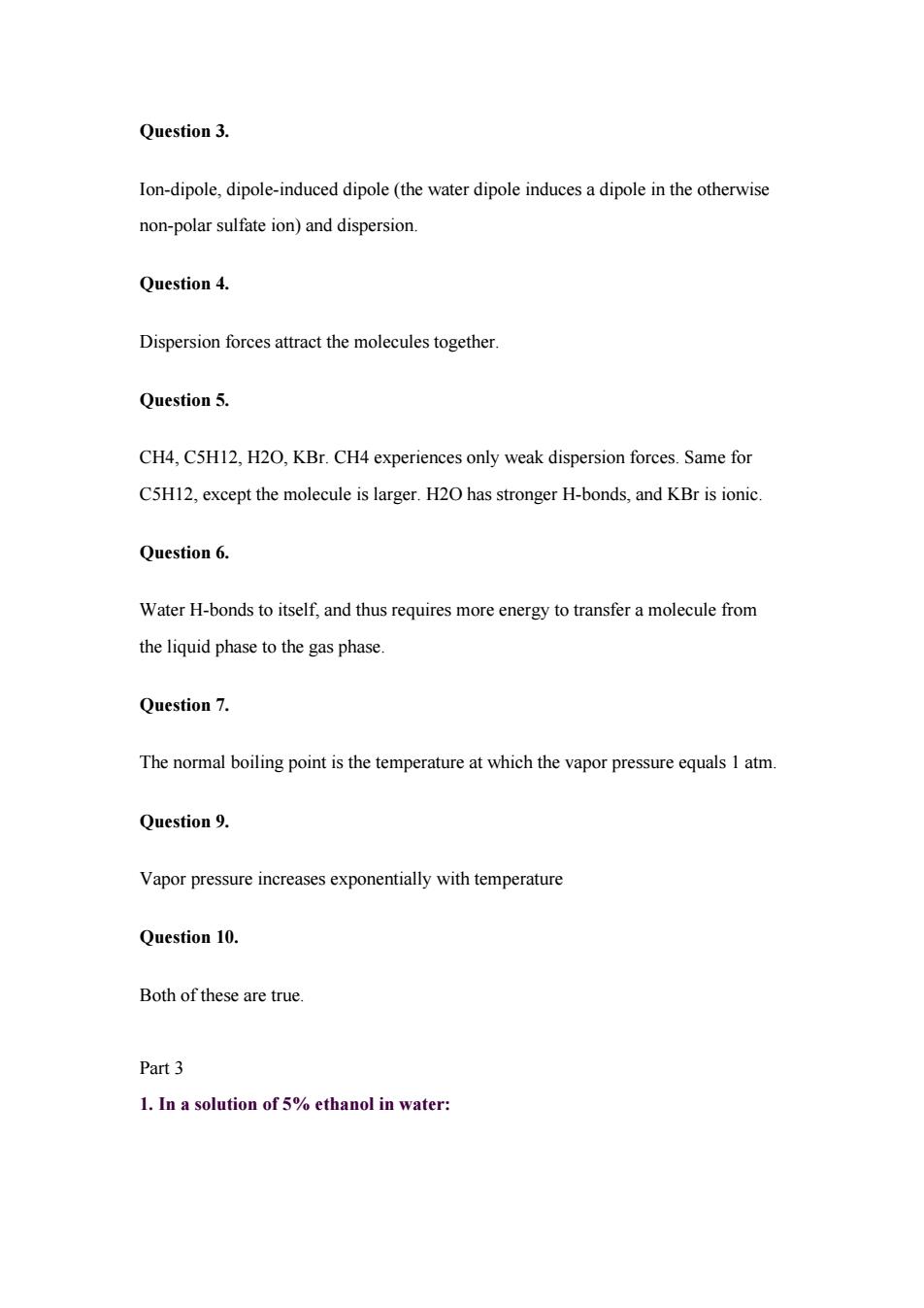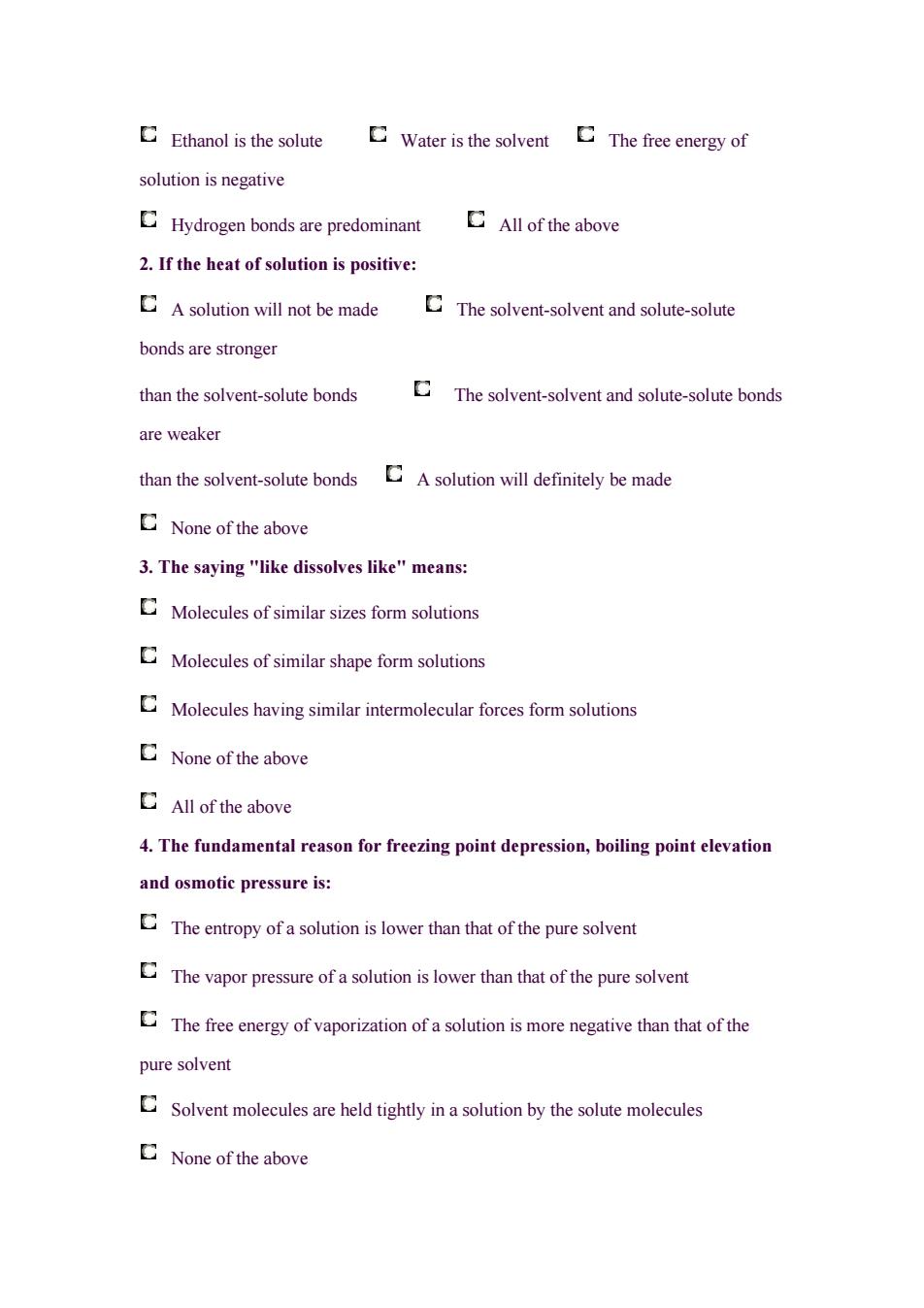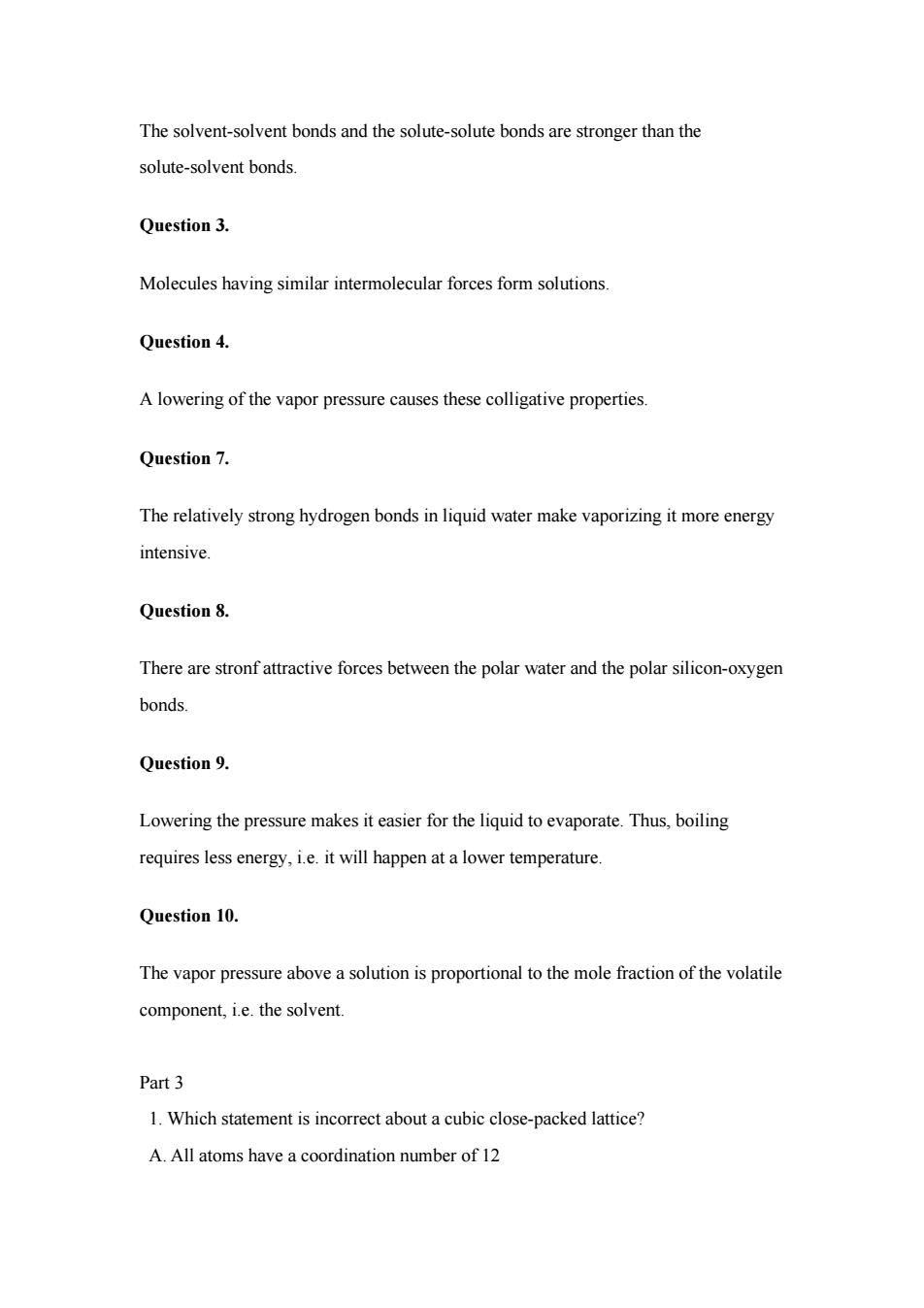
Chapter 10 Solid Structure Part 1 1.Explain what is meant by (a)a Schottky defect in CaCl2,and (b)a Frenkel defect in AgBr.(c)Suggest what effect doping crystals of AgCl with CdCl2 might have on the AgCl lattice structure. 2.Suggest why doping NiO with Li in air (or the presence ofO)leads to an increase in electrical conductivity,and comment on the dependence of this increase on the amount of lithium dopant. 3.Comment on the structural and compositional implications of(a)the Fe-deficiency of iron(II)oxide,and(b)the anion-excess nature of uranium(IV)oxide. 4.Give a brief outline of a typical CVD process and give examples of its use in the semiconductor industry. 5.(a)Describe the structure of lithium nitride and explain how it is able to function as a lithium ion conductor.The structures of LisP and LisAs are analogous to that of the nitride.How do you expect the degree of ionic character in these compounds to vary? (b)Epitaxial MgB2 films can be grown from B2H6 and Mg vapour at temperatures up to 1030 K.Explain the meaning of epitaxial'and state what particular properties the films possess Part2 1.Identify all of the intermolecular forces in HF Dipole-dipole only CH-bonds only H-bonds and dispersion
Chapter 10 Solid Structure Part 1 1. Explain what is meant by (a) a Schottky defect in CaCl2, and (b) a Frenkel defect in AgBr. (c) Suggest what effect doping crystals of AgCl with CdCl2 might have on the AgCl lattice structure. 2. Suggest why doping NiO with Li2O in air (or the presence of O2) leads to an increase in electrical conductivity, and comment on the dependence of this increase on the amount of lithium dopant. 3. Comment on the structural and compositional implications of (a) the Fe-deficiency of iron(II) oxide, and (b) the anion-excess nature of uranium(IV) oxide. 4. Give a brief outline of a typical CVD process and give examples of its use in the semiconductor industry. 5. (a) Describe the structure of lithium nitride and explain how it is able to function as a lithium ion conductor. The structures of Li3P and Li3As are analogous to that of the nitride. How do you expect the degree of ionic character in these compounds to vary? (b) Epitaxial MgB2 films can be grown from B2H6 and Mg vapour at temperatures up to 1030 K. Explain the meaning of ‘epitaxial’ and state what particular properties the films possess. Part 2 1. Identify all of the intermolecular forces in HF(g): Dipole - dipole only H-bonds only H-bonds and dispersion

Ion-dipole and dispersion None of the above are completely corret 2.Identify all of the intermolecular forces in NHCl: Dispersion forces only H-bonds and dispersion H-bonds.dipole-dipole and dispersion Dipole-nducedipandisprsion lon-dipole and dispersion 3.Identify all of the intermolecular forces between H2O and the sulfate ion, SO: Dispersion forces only Ion-ipol and dispersion Ion-dipole,dipole-dipole and dispersion on-ipeipdueipandisprsio None ofthe above are completely correct 4.The gaseous non-polar molecule CCl can condense to a liquid because The C-Clbonds are very polar Dipoiprahe moother Dispersion the Dipole-indued dipolforeart the moleculesnother 5.Arrange the following species in increasing order of boiling temperature:
Ion-dipole and dispersion None of the above are completely correct 2. Identify all of the intermolecular forces in NH4Cl(g): Dispersion forces only H-bonds and dispersion H-bonds, dipole-dipole and dispersion Dipole-induced dipole and dispersion Ion-dipole and dispersion 3. Identify all of the intermolecular forces between H2O(l) and the sulfate ion, SO4 -2 (aq): Dispersion forces only Ion-dipole and dispersion Ion-dipole, dipole-dipole and dispersion Ion-dipole, dipole-induced dipole and dispersion. None of the above are completely correct 4. The gaseous non-polar molecule CCl4(g) can condense to a liquid because: The C-Cl bonds are very polar Dipole-dipole interactions attract the molecules to one another Dispersion forces attract the molecules to one another Dipole-induced dipole forces attract the molecules to one another 5. Arrange the following species in increasing order of boiling temperature:

CH4,CsH12,KBr,H2O CH CsHz,KBr,H:0 CCH4 CsH12,H2O,KBr CsHn2,CH4,H2O,KBr CCH4,KBr,CsHi2,H2O 口CL,H,O,KBr,CsH2 6.Why is the heat of vaporization of water greater than that of pentane, CsHp2? The change in entropy is much larger for peatane Pentane molecules repel one another CThe molecular weight of pentane is larger Pentane hydrogen bonds to itself Water hydrogen bonds to itself 7.What is meant by the term"normal boiling point?" The point at which the solution becomes IN in The temperature at which the liquid boils The temperature at which the vapor pressure The temperatue at which the gas and liquid are inequrm None of the above 8.Water boils at a lower temperatue at higher altitudes because: The atmospheric pressure is lower The solar radiation is more intense
CH4, C5H12, KBr, H2O CH4, C5H12, KBr, H2O CH4, C5H12, H2O, KBr C5H12, CH4, H2O, KBr CH4, KBr, C5H12, H2O CH4, H2O, KBr, C5H12 6. Why is the heat of vaporization of water greater than that of pentane, C5H12? The change in entropy is much larger for pentane Pentane molecules repel one another The molecular weight of pentane is larger Pentane hydrogen bonds to itself Water hydrogen bonds to itself 7. What is meant by the term "normal boiling point?" The point at which the solution becomes 1 N in concentration The temperature at which the liquid boils The temperature at which the vapor pressure equals 1 atm The temperatue at which the gas and liquid are in equilibrium None of the above 8. Water boils at a lower temperatue at higher altitudes because: The atmospheric pressure is lower The solar radiation is more intense

CThe clouds are lower Liquid water is less denseat hig atitude None of the above 9.The Clausius Clapeyron equation predicts: Vapor pressure is a linear function of temperature Vapor pressure decreases exponetially with temperature Vapor pressure inereases exponentially with temperature Vapor pressure is not a function of temperature 10.The entropy of vaporization for most liquids is approximately 88 JKmo because: The ratio does no vary much from one liquid toanother The difference in density from the liquid to the gas is about the same for most liquids CBoth of the above Neither of the above Answer: Question I. HF experiences H-bonds and dispersion forces. Question 2. H-bonds(H is bound to N).dipole-dipole(the N-CI bond is also polar)and dispersion forces
The clouds are lower Liquid water is less dense at high altitude None of the above 9. The Clausius Clapeyron equation predicts: Vapor pressure is a linear function of temperature Vapor pressure increases logarithmically with temperature Vapor pressure decreases exponetially with temperature Vapor pressure increases exponentially with temperature Vapor pressure is not a function of temperature 10. The entropy of vaporization for most liquids is approximately 88 J K-1 mol-1 because: The ratio H/T b does not vary much from one liquid to another The difference in density from the liquid to the gas is about the same for most liquids Both of the above Neither of the above Answer: Question 1. HF experiences H-bonds and dispersion forces. Question 2. H-bonds (H is bound to N), dipole-dipole (the N-Cl bond is also polar) and dispersion forces

Question 3. Ion-dipole,dipole-induced dipole (the water dipole induces a dipole in the otherwise non-polar sulfate ion)and dispersion. Question 4 Dispersion forces attract the molecules together. Question 5. CH4,C5H12,H20,KBr.CH4 experiences only weak dispersion forces.Same for C5H12,except the molecule is larger.H2O has stronger H-bonds,and KBr is ioni Question 6. Water H-bonds to itself,and thus requires more energy to transfer a molecule from the liquid phase to the gas phase. Question 7. The normal boiling point is the temperature at which the vapor pressure equals 1 atm. Question 9. Vapor pressure increases exponentially with temperature Question 10. Both of these are true. Part3 1.In a solution of 5%ethanol in water
Question 3. Ion-dipole, dipole-induced dipole (the water dipole induces a dipole in the otherwise non-polar sulfate ion) and dispersion. Question 4. Dispersion forces attract the molecules together. Question 5. CH4, C5H12, H2O, KBr. CH4 experiences only weak dispersion forces. Same for C5H12, except the molecule is larger. H2O has stronger H-bonds, and KBr is ionic. Question 6. Water H-bonds to itself, and thus requires more energy to transfer a molecule from the liquid phase to the gas phase. Question 7. The normal boiling point is the temperature at which the vapor pressure equals 1 atm. Question 9. Vapor pressure increases exponentially with temperature Question 10. Both of these are true. Part 3 1. In a solution of 5% ethanol in water:

Ethanol is the solute Water is the solventThe free energy of solution is negative Hydrogen bonds are predominant CAll of the above 2.If the heat of solution is positive: A solution will not be made The solvent-solvent and solute-solute bonds are stronger than the solvent-solute bonds The solvent-solvent and solute-solute bonds are weaker than the solvent-solute bondsA solution will definitely be made None of the above 3.The saying"like dissolves like"means: Molecules of similar sizes form solutions Moleculesof smiar shape Molecules having similar intermolecular forces form solutions None of the above All of the above 4.The fundamental reason for freezing point depression,boiling point elevation and osmotic pressure is: Theenropyofsoiniser than that ofthe pureso The vapor pressure fithan tha fh puresoe The than that pure solvent Sovent moecule are held tighty insoio by thesoemoue None of the above
Ethanol is the solute Water is the solvent The free energy of solution is negative Hydrogen bonds are predominant All of the above 2. If the heat of solution is positive: A solution will not be made The solvent-solvent and solute-solute bonds are stronger than the solvent-solute bonds The solvent-solvent and solute-solute bonds are weaker than the solvent-solute bonds A solution will definitely be made None of the above 3. The saying "like dissolves like" means: Molecules of similar sizes form solutions Molecules of similar shape form solutions Molecules having similar intermolecular forces form solutions None of the above All of the above 4. The fundamental reason for freezing point depression, boiling point elevation and osmotic pressure is: The entropy of a solution is lower than that of the pure solvent The vapor pressure of a solution is lower than that of the pure solvent The free energy of vaporization of a solution is more negative than that of the pure solvent Solvent molecules are held tightly in a solution by the solute molecules None of the above

5.Which of the following statements is true? Theeryosopi constantis fuetion fhe identityfhoue The value ofthe ebullioscopic constant depends on how much solute is present The osmotic pressure is not a function of temperature Themagnitude ofthe freenont depressond boiling ointinhe same for a given solution None of the above 6.A 1 m solution of NaCl has a lower boiling point than 1m NazSO Why? 1m NaSO conin more ions than 1m NaCk The SOion is larger than the Cr ion Na,SO has a larger molecular weight than NaCI NaCl has a lower boiling point than Na None of the above 7.Water has a higher boiling point than helium because: Water hasa higher moleuar weight than helium Water hydrogen bonds with itsefand helium does no Water has larger dispersion forces than doeshelium Heliumiswaysasitdes not have a boiling point None of the above 8.Liquid water will rise up a narrow capillary tube because Water and glass are made of the same molecule
5. Which of the following statements is true? The cryoscopic constant is a function of the identity of the solute The value of the ebullioscopic constant depends on how much solute is present The osmotic pressure is not a function of temperature The magnitude of the freezing point depression and boiling point elevation are the same for a given solution None of the above 6. A 1 m solution of NaCl(aq) has a lower boiling point than 1 m Na2SO4(aq). Why? 1 m Na2SO4(aq) contains more ions than 1 m NaCl(aq) The SO4 -2 ion is larger than the Cl- ion Na2SO4 has a larger molecular weight than NaCl NaCl(l) has a lower boiling point than Na2SO4(l) None of the above 7. Water has a higher boiling point than helium because: Water has a higher molecular weight than helium Water hydrogen bonds with itself and helium does not Water has larger dispersion forces than does helium Helium is always a gas - it does not have a boiling point None of the above 8. Liquid water will rise up a narrow capillary tube because: Water and glass are made of the same molecules

The water is trying to esape from the caillary There are sron atiractive fores between the glass and the water Glass is electrostatically charged 9.Boiling point is a function of the existing atmospheric pressure because: Higher pressure usually means warmer weather Higher pressure causesmoreair to dissolve in theliquid None of the above 10.Raoult's law states: Ifyou murder someone,you will go tojail Thevapor prerishiher thntha fth ursovnt involatile solute The vapor pressure boveoisoprionthevapr esure of the pure involatile solute The vapor pressure bovsotinis oprialto the moe fraction ofh solvent Answer: Question 1. All of these are truel Question 2
The water is trying to escape from the caillary There are strong attractive forces between the glass and the water Glass is electrostatically charged 9. Boiling point is a function of the existing atmospheric pressure because: Higher pressure usually means warmer weather Lower pressure allows "easier" evaporation of the liquid Higher pressure causes more air to dissolve in the liquid None of the above 10. Raoult's law states: If you murder someone, you will go to jail The vapor pressure above a solution is higher than that of the pure solvent The vapor pressure above a solution is proportional to the mole fraction of the involatile solute The vapor pressure above a solution is proportional to the vapor pressure of the pure involatile solute The vapor pressure above a solution is proportional to the mole fraction of the solvent Answer: Question 1. All of these are true! Question 2

The solvent-solvent bonds and the solute-solute bonds are stronger than the solute-solvent bonds. Question 3. Molecules having similar intermolecular forces form solutions Question 4. A lowering of the vapor pressure causes these colligative properties. Question 7. The relatively strong hydrogen bonds in liquid water make vaporizing it more energy intensive. Question 8. There are stronf attractive forces between the polar water and the polar silicon-oxygen bonds. Question 9. Lowering the pressure makes it easier for the liquid to evaporate.Thus,boiling requires less energy,ie.it will happen at a lower temperature. Question 10. The vapor pressure above a solution is proportional to the mole fraction of the volatile component,i.e.the solvent. Part3 1.Which statement is incorrect about a cubic close-packed lattice? A.All atoms have a coordination number of 12
The solvent-solvent bonds and the solute-solute bonds are stronger than the solute-solvent bonds. Question 3. Molecules having similar intermolecular forces form solutions. Question 4. A lowering of the vapor pressure causes these colligative properties. Question 7. The relatively strong hydrogen bonds in liquid water make vaporizing it more energy intensive. Question 8. There are stronf attractive forces between the polar water and the polar silicon-oxygen bonds. Question 9. Lowering the pressure makes it easier for the liquid to evaporate. Thus, boiling requires less energy, i.e. it will happen at a lower temperature. Question 10. The vapor pressure above a solution is proportional to the mole fraction of the volatile component, i.e. the solvent. Part 3 1. Which statement is incorrect about a cubic close-packed lattice? A. All atoms have a coordination number of 12

B.The lattice contains both tetrahedral and octahedral holes C.Layers of close-packed atoms are stacked in an ABABAB...pattern D.The packing is more efficient than in a body-centred cubic lattice 2.The coordination numbers of spheres in body-centred cubic,simple cubic and cubic close-packed lattices are,respectively: A.8,6,12 B.6,8.12 C.6,128 D.8,12,12 3.Look at Table 6.2 in Inorganic Chemistry.Use the data to estimate the metallic radius of Ba in metallic barium at 298 K.The value(in pm)is: A.231 B.217 C.215 D.197 4.Which statement is true? A.The electrical conductivity of a metal increases with temperature B.The electrical conductivity of a semiconductor increases with temperature C.The resistivity of a semiconductor increases with temperature D.Metals and semiconductors have similar electrical conducting properties 5.The behaviour of metals and semiconductors is usually discussed in terms of band theory.Which statement is not true? A.A partially filled band is characteristic of a metal B.Doping Siwith As enhances its semiconducting properties C.Band gaps vary among different semiconductors but are always relatively large D.Band gaps for insulators are large
B. The lattice contains both tetrahedral and octahedral holes C. Layers of close-packed atoms are stacked in an ABABAB... pattern D. The packing is more efficient than in a body-centred cubic lattice 2. The coordination numbers of spheres in body-centred cubic, simple cubic and cubic close-packed lattices are, respectively: A. 8, 6, 12 B. 6, 8, 12 C. 6, 12, 8 D. 8, 12, 12 3. Look at Table 6.2 in Inorganic Chemistry. Use the data to estimate the metallic radius of Ba in metallic barium at 298 K. The value (in pm) is: A. 231 B. 217 C. 215 D. 197 4. Which statement is true? A. The electrical conductivity of a metal increases with temperature B. The electrical conductivity of a semiconductor increases with temperature C. The resistivity of a semiconductor increases with temperature D. Metals and semiconductors have similar electrical conducting properties 5. The behaviour of metals and semiconductors is usually discussed in terms of band theory. Which statement is not true? A. A partially filled band is characteristic of a metal B. Doping Si with As enhances its semiconducting properties C. Band gaps vary among different semiconductors but are always relatively large D. Band gaps for insulators are large